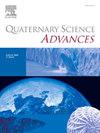希腊伊庇鲁斯(Thesprotia)卡拉马斯河三角洲全新世中晚期古地理演化
IF 2.2
Q2 GEOGRAPHY, PHYSICAL
引用次数: 0
摘要
本文研究了希腊伊庇鲁斯地区第二大三角洲Kalamas河三角洲全新世中晚期的古地理演化,该三角洲虽然具有重要的考古意义,但却缺乏全面的古环境研究。通过跨学科的方法,该研究将地貌实地调查、电阻率断层扫描(ERT)剖面、岩心钻探、沉积学和微动物分析与放射性碳定年相结合。这些发现揭示了三角洲演化的四个重要阶段。最初,淡水湿地存在于三角洲的东南部,直到至少7429-7280 cal. BP。随后,大约6627-6402 cal. BP,海侵高峰建立了以浅海为主的海洋环境。大约5590-5191 cal. BP,三角洲加速退化导致开放和受限泻湖的发展,可能是由广泛的沿海屏障或沙口形成的。从公元前1874年到1719年,在古代,特别是在罗马时期,陆地冲积沉积变得普遍,在随后的几个世纪中继续进行三角洲沉积。这些结果为了解形成卡拉马斯三角洲的地貌过程提供了重要的见解,并强调了由环境变化和沉积过程引起的地貌学偏差,这可能是地表考古遗迹明显缺乏的原因——许多遗址可能已经被破坏或埋在沉积物下。本文章由计算机程序翻译,如有差异,请以英文原文为准。
Mid-to late Holocene palaeogeographic evolution of the Kalamas river delta, Epirus (Thesprotia), Greece
This paper examines the mid-to-late Holocene palaeogeographical evolution of the Kalamas river delta, the second largest delta in Epirus, Greece, which had previously lacked comprehensive palaeoenvironmental investigation despite its archaeological significance. Through an interdisciplinary approach, the research integrates geomorphological field surveys, Electrical Resistivity Tomography (ERT) profiles, core drilling, sedimentological and microfaunal analyses, associated with radiocarbon dating. The findings reveal four significant phases in the delta's evolution. Initially, freshwater wetlands existed in the southeastern part of the delta until at least 7429-7280 cal. BP. Subsequently, around 6627-6402 cal. BP, a peak in marine transgression established predominantly shallow marine environments. By approximately 5590-5191 cal. BP, accelerated delta progradation led to the development of open and restricted lagoons, likely formed by extensive littoral barriers or sandy spits. From 1874 to 1719 cal. BP, during the Antiquity and particularly during the Roman period, terrestrial alluvial sedimentation became prevalent, with continued delta progradation in subsequent centuries.
These results provide crucial insights into the geomorphological processes that have shaped the Kalamas delta and emphasize the taphonomic biases induced by environmental changes and progradation processes, which may account for the apparent lack of surface archaeological remains—many sites may have been destroyed or buried under sediment.
求助全文
通过发布文献求助,成功后即可免费获取论文全文。
去求助
来源期刊

Quaternary Science Advances
Earth and Planetary Sciences-Earth-Surface Processes
CiteScore
4.00
自引率
13.30%
发文量
16
审稿时长
61 days
 求助内容:
求助内容: 应助结果提醒方式:
应助结果提醒方式:


